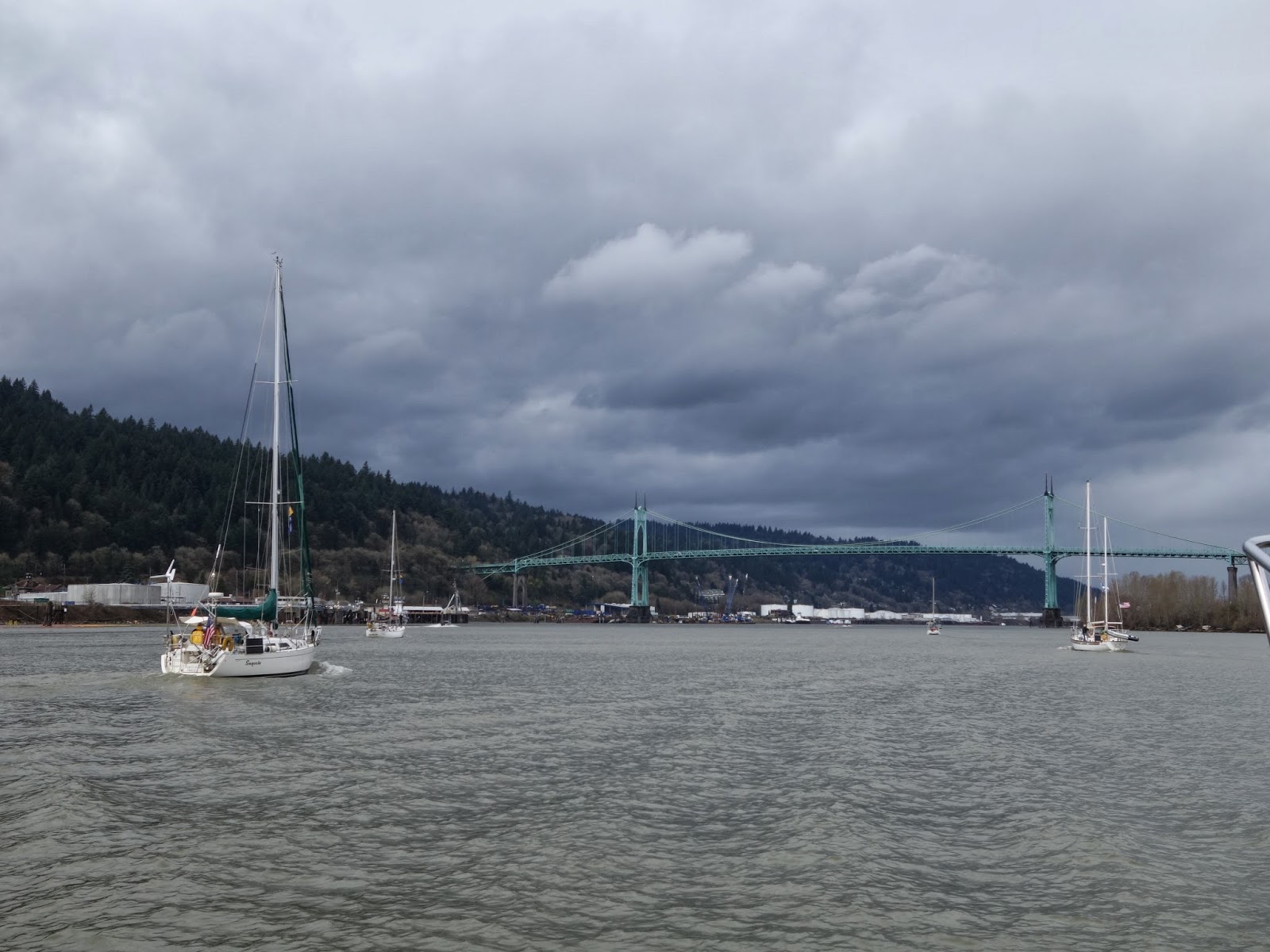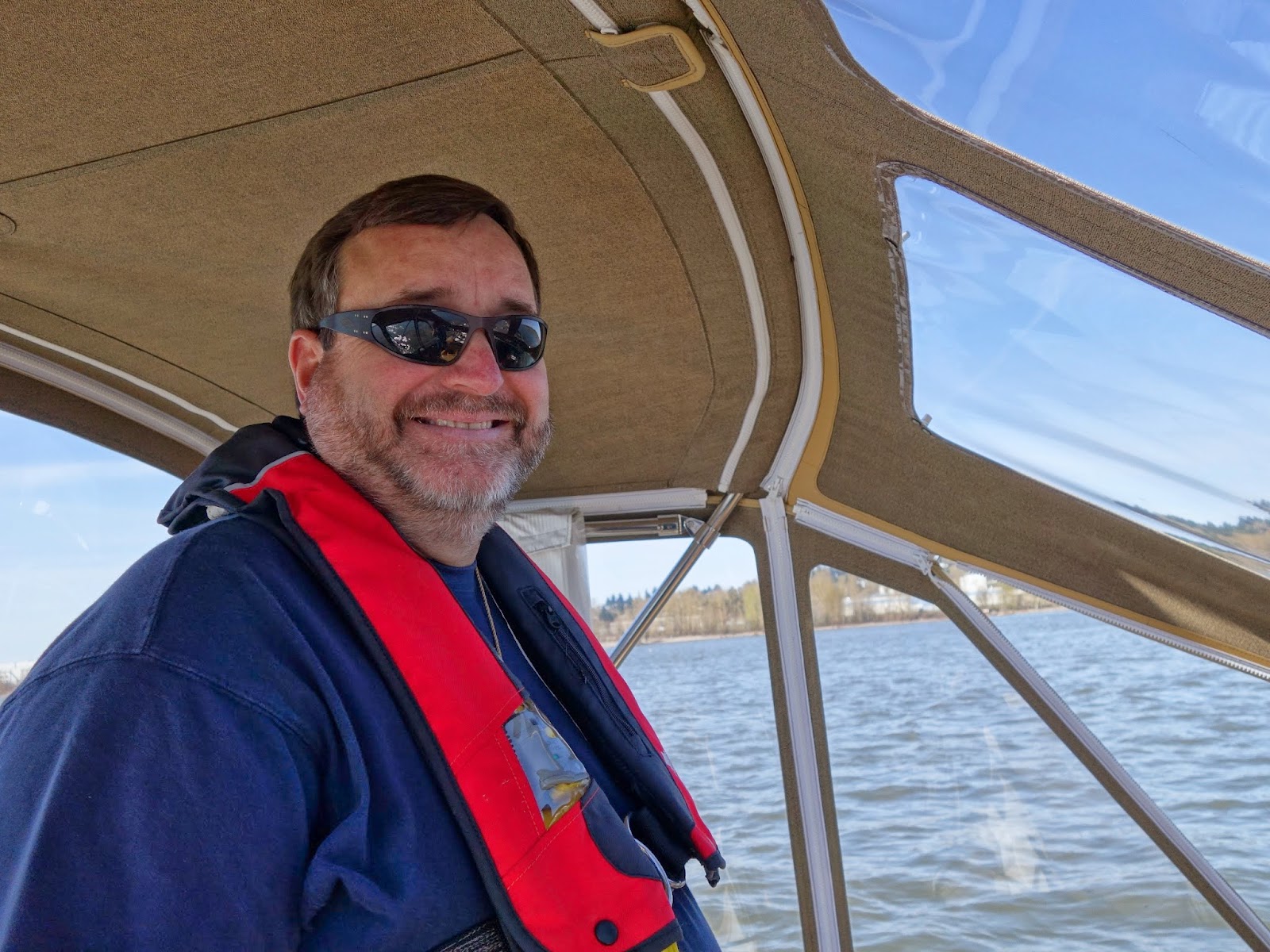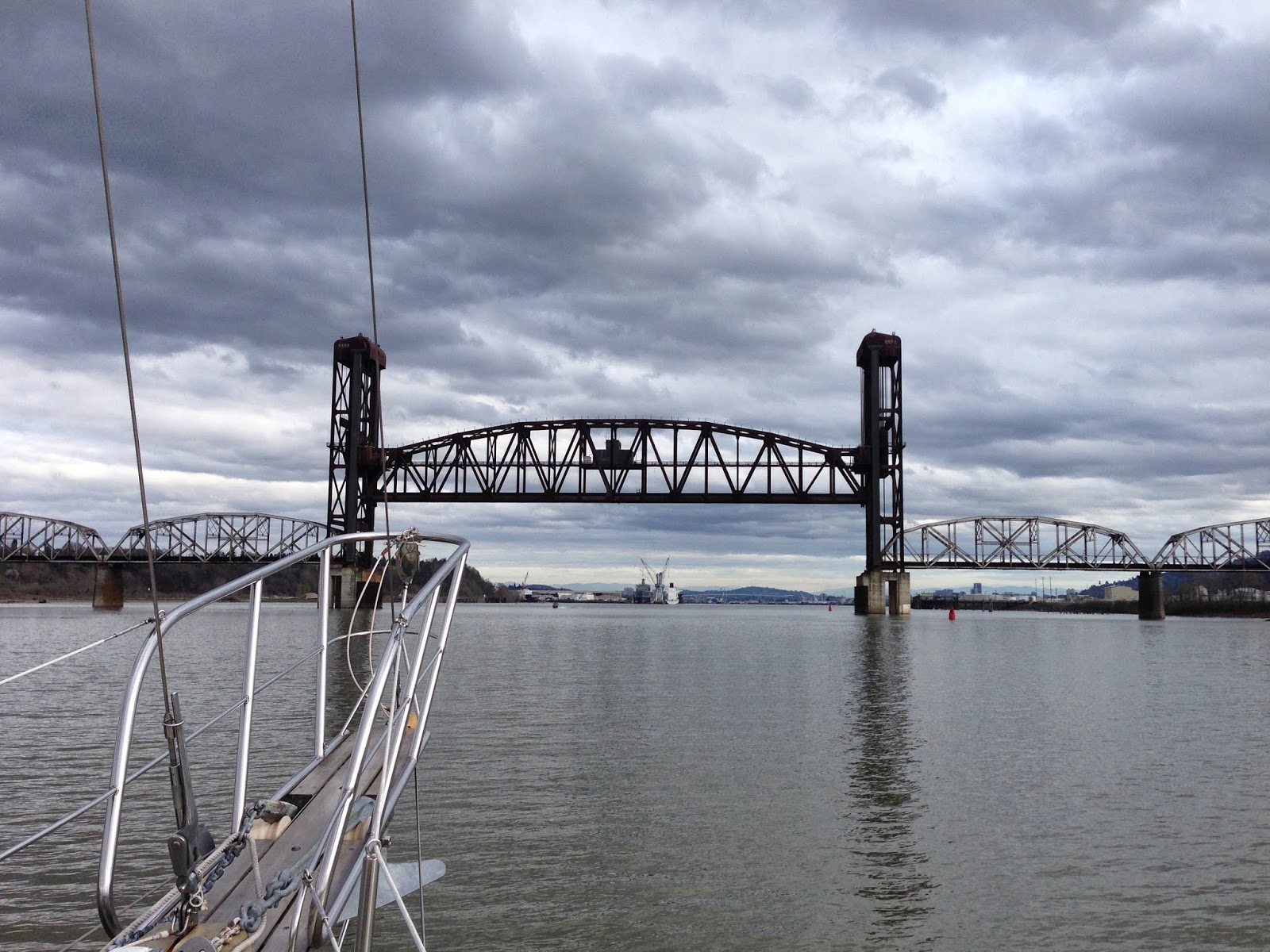As winter set in here in Oregon, I looked forward to starting the sailing and cruising season. I felt like Ishmael at the beginning of Moby Dick. Instead of knocking people's hat's off or following funerals, I sunk into watching sailing movies. The Sauvie Island Yacht Club's first cruise of the new year, to Swan Island Basin could come soon enough. To me what could be better then my favorite holiday (St. Patrick's Day) and a small boat cruise rolled into one!
But the strong anticipation was in January, as snow piled up outside, and me having no clue where Swan Island Basin was even located or what it was like. As the time drew near, I whipped out the old charts and found it was right in the middle of the Portland Shipping Yards. The yacht club called it an anchoring cruise; in not what one would think of as an idyllic place. I must have gotten something wrong in my understanding of the club's intentions and location. I emailed the commodore, questioning him; thinking I must have the location wrong. He emailed back and said I hadn't. He must know what he's doing I thought; after all he's been at cruising around Portland a while.
A quick search of the internet and I found another blogger from S/V 'Imi Loa, who had done the same cruise with the club in March 2011. They said,
"It was a great weekend. We sailed, we moved the boat at night, we found a new anchorage, we rafted up. A bunch of new stuff to add to our box of tricks." To me that was enough of an endorsement, so off we went to planning our weekend cruise.
I started with the navigation, as the crow flies the anchorage at Swan Island Basin is only 3.6NM away from our marina at Salpare Bay. By river the trip is nearly 14NM, and requires at least two bridge lifts. I committed the waypoints to memory, while we watched the developments in the weather. The forecast was for a sunny 60oF weekend. Perfect cruising weather, we were getting excited about the weekend.
The next step was to ensure the cockpit enclosure was finished (but that's another post). On Thursday before we were to set off the enclosure doors were still not finish. It was going to be a cold night on the boat if we couldn't keep some of the heat in.
Charing found great decorations at several places for cheap. She found a shamrock 3 foot high that we raised up the mast using the flag halyard. To match her decoration she bought napkins with shamrocks and a green serving platter. A goofy (only in America) green felt Irish top hat, and a badge proclaiming a Very Irish Person were used to show our Irish pride. We even brought along the tricolors but weren't in a position to raise them on the cruise. (Coast Guard was just up from the anchorage).
I'd planned on cooking up Irish Stew, to take with us. I bought all the good stuff to make it great. I cooked a large pot of it, but failed to account for a hungry teenage son, and family dinner on Friday. The majority of the stew was gone, just hours after cutting the veggies for it.
Saturday finally came and we were off to a slow start. In fact we didn't get to the boat until about 12:30pm. We had to stock up on food that was consumed from the night before. When we arrived at the boat the enclosure was completely done and we were amazed at how great it looked. We were shock even more to see how warm it was inside now. We loaded the boat, and put everything in it's place. Charing went off to gather ice while I started the engine.
The water level had been growing higher and higher in the river with the recent rains, so I decided to call the I-5 bridge to check the clearance on the VHF radio. The conversation went very much like this:
- CarolMarie: I-5 Bridge this is the sailing vessel CarolMarie.
- I-5Bridge: This is I-5 Bridge go ahead.
- CarolMarie: I-5 Bridge, this is the sailing vessel CarolMarie, can you tell me the the midspan bridge clearance?
- I-5 Bridge: The clearance now mid-span is 58 feet.
- CarolMarie: I-5 Bridge, we are sailing vessel needing 60 feet of clearance can you accommodate a lift for us?
- I-5 Bridge: CarolMarie, does that 60 feet include your antennas? Are they up?
- CarolMarie: Affirmative, that's 60 feet includes our antennas.
- I-5 Bridge: CarolMarie, I can lift it for you this time, but next time lower your antennas before you ask.
- CarolMarie: I-5 Bridge, we are a sailing vessel. I can't climb the mast all the time to raise and lower the antennas, thank you for the lift.
- I-5 Bridge: Oh... sorry.
 |
| I-5 Bridge starting to go up as we approached it. |
After getting the ice, we dawned our PFD's, cast of the lines from the dock and we were off. By 1:10pm we were at the I-5 Bridge. The bridge tender now knowing who we were, stopped traffic and lifted the bridge for us. It was my first time under the bridge with it lifted. Charing was amazed we didn't have to pay a thing for it. I reminded her we pay dearly for the service every April 15th.
 |
| Vancouver Railroad bridge swinging open |
Following the I-5 bridge the next one is the Vancouver Railroad bridge. I hailed the tender on the VHF, who was already anticipating our call. He said he'd get to us as soon as he could clear some traffic. We motored near the bridge and pointed the boat back up river idling the engine. The idle gave us just enough power to remain stationary in the river about 400 yards from the bridge.
 |
| Amount of wood and logs flowing down the Columbia River |
I am always nervous at this point because if the engine fails there is little time to get the anchor down before slamming into the bridge with the mast up. Charing must have sensed my tension and asked what was up. I told her I am always nervous because the engine could fail and we'd have problems. Like an experienced pro she quickly said, "well, we'd just run and drop anchor real fast." I was very proud of her then.
We finally cleared the Vancouver Railroad bridge and had a nice motor down the Columbia to Kelley Point where we'd turn up the Willamette River. We saw immediately the impact of the longshoreman's strike; there were cargo ships lined up as far as we could see all anchored waiting to be loaded or unloaded.
We made the turn at Kelley Point up the Willamette, and I became nostalgic about all the sailing I had done on this part of the river. Every opportunity I could I grabbed a friend or went by myself up and down this stretch of the Willamette. I knew every ripple in the water and where to get the best lift and speed.
About 5NM up the Willamette we went under the gothic St. John's Bridge. The deck of the bridge towered 250 feet above our boat, with her classic green patina. At 6NM up the river it was time for the last lift of the trip at the St. John's Railroad Bridge. The tender said he had some train traffic coming to hold on while they cleared it.
 |
| St. John's Bridge on the Willamette River |
Once cleared of the bridge we got to the Swan Island Dry Docks. We saw four of them each filled with a large vessel being repaired. The first one was a Navy ship of some type, with the glow of the welder's torches being easily seen below the massive ship. Another had a fishing vessel and the third a passenger vessel for Alaska Cruises.
At 8NM up the Willamette we turned into the basin to find the rest of the SIYC cruisers. By now it was 5:20pm and I was afraid we'd be anchoring in the dark. We found the group there at the end of the basin, rafted up like a photo you'd seen in Cruising World Magazine. I called them on the VHF. The commodore responded and said to drop my anchor southwest of the group 30 yards. As we approached I saw a couple of anchor balls surrounding the group.
Now time for a confession on my part. I have anchored out slept several times, but never rafted up to anyone, so this was all new to me. The very thought of anchoring then drifting around until I came up to another boat scare me enough to think twice about just leaving the anchorage all together. I decided it was best to circle them and see with situation first hand. As we elegantly motored around them the commodore on VHF showed me exactly where to drop anchor. Not wanting make a fool of myself we saw the place and on a second trip around got to where he had instructed us to drop anchor.
Now Charing and I switched places as I dropped the anchor and she manned the helm. I put the handheld VHF in my pocket and went forward to do the deed. As the anchor bit we drifted back with the engine in idle. He instructed us to tie up to S/V Conch, and to drift towards her. As we did all the men gathered on Conch to help fend off the boats and ensure the rub rails and spreaders didn't collide with each other. Under constant vigilance of all the skippers we drifted into place as if the entire thing was orchestrated by a higher power (ok it was the commodore after all). The boats were then tied together and the men said dinner was to be served at 6:00pm. I looked at my phone and it was 5:59pm. I looked up to find the crowd of men once on Conch had disappeared; on their way to dinner on S/V Sequoia. In that same movement, the hand held VHF that was once in my pocket fell out, right into the small gap between the two boats. I recovered it with a prayer and a boathook. Then went down stairs to help Charing with our dish for the potluck.
I was happy we had gotten there with no issues and stayed warm and dry. My glee was short lived when I turned on the water pressure pump for the boat's fresh water source. I heard water rushing out, which turned out to be the hose to the head's vanity sink. The pipe must have frozen over the winter and broke once we turned on the water. Soon water was all over the cabin floor. We quickly cleaned it up and got our dish ready. We made our way over to Sequoia, to join the others. Charing has prepared "Irish Nacho's" and a "pot of gold". The pot of gold was a bucket full of Guinness beer, and Irish Whiskey - my favorite.
We ate and share company with fellow cruisers. The topic came up about the anchorage, to which several of the older cruisers said it reminded them of coming into large-city third world ports in Southeast Asia. Being out with the group wasn't that bad, and the calm warm evening was relaxing. As the evening went on we invite Ray and Alicia over to the CarolMarie to catch up and for a shot of Connemara. Ray and Alicia sailed in and live on S/V Rowena, a Formosa Ketch. They are planning on taking Rowena south this summer so there fixing her up and shaking things down. Charing and Alicia wanted to plan a cruise to Canada for the summer as an initial off shore shake down. It could be great fun to head up to Barkley Sound for a week or two.
By 11:00pm we turned in. I looked out of my skylight and with the full moon illuminating the forestay and mast of Conch I got a reference of where we were in case the anchor slipped or drug in the night. Through the night the winds built up, and the boats rocked back and forth in the anchorage. Their rocking of course caused the fenders to squeal and halyards to bang. With all the noise we awoke a few times to look up and see there was no relative movement between our two boats.
At 8:30am we woke up and prepared coffee. I headed over to Sequoia for breakfast, Charing soon followed. Not being much of breakfast eater we when for socializing and to learn more from those who'd been out there. The array of different breakfast dishes was impressive, but I had little appetite in the morning. We talked about going up to Barkley Sound, and Susan pulled out a chart of the area, showing us the high points of where to go.
Gary was kind enough to come over to the CarolMarie and look into moving the toilet to a usable spot. He said he'd be happy to do the job, which was news to our ears. We'd been looking for someone for two years now.
After a great time the morning was soon almost gone, and by 10:30am we need to get underway. We gathered up our anchor as we drifted around the anchorage, idling the motor. With the anchor up, we slowly motored out of the basin as others followed behind us.
As I approached the end of the basin a line of deadheads appeared to block the exit. We came in close to dry docks, and avoided running into them. Once all the boats were clear of the basin, Terry on S/V Conch called for the Vancouver Railroad bridge lift. Once it was lifted everyone motored through quickly passing us by while dodging the salmon fishermen.
 |
| S/V Rowena after passing under the St.John's Railroad Bridge |
 |
| S/V Sequoia passing under the St. John's Rail Road Bridge |
 |
| S/V Julia Max going under St. John's Bridge |
 |
| Everyone headed home.... |
We trailed behind S/V Rowena for most of the trip down the Willamette, while watching S/V Julia Max motor sail with her jib up. A light rain started to fall as we moved onto the Columbia and lost site of Julia Max. We continued to follow Rowena up river until the passing power boaters gave us such a trashing, we sought cover behind the moored cargo ships. Gary, having been much more experienced then we were started by hiding in their shadows, and was soon way ahead of us.
By the time we got to the railroad bridge it was open already and we raced through. I called Julia Max who'd cleared the I-5 Bridge before us, and asked for their observed clearance. There was no reason to ask for a lift because water levels were lower then before.
When we pulled into Salpare Bay the winds kicked up making tying up challenging. We reached the slip and were immediate blown across the slip too far to jump off. I cut back and forth on the engine and managed to jump off with a line. But again the wind kicked up and blew the boat back across the slip. I finally got the boat back over to our side, and tied her off.
Cleaning up the boat was a game of hide and seek with the weather. Every time I saw the rain and wind die down I jumped out to clean up more stuff on the deck only to be fooled by the weather. A sudden gust of wind would come up and the rain pelted me. I would run back into the cockpit to warm up, and wait only to repeat the same thing over and over. On the third time I gave up, and just stayed out in it getting soak and wet as I put the CarolMarie to bed for the week.
I guess in summary the previous blogger said it best,
"It was a great weekend. We sailed, we moved the boat at night, we found a new anchorage, we rafted up. A bunch of new stuff to add to our box of tricks." Thanks to Craig, Ray, Terry, Gary, Barbara, Alicia, Susan, and George for all the advise, help and fun weekend.


























